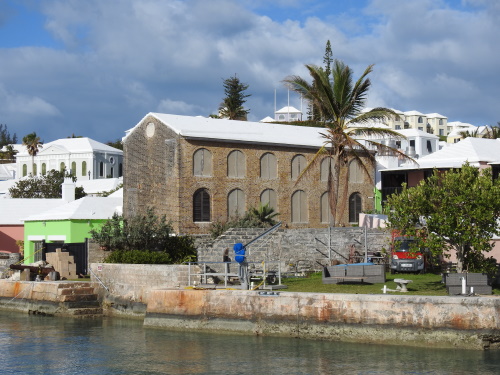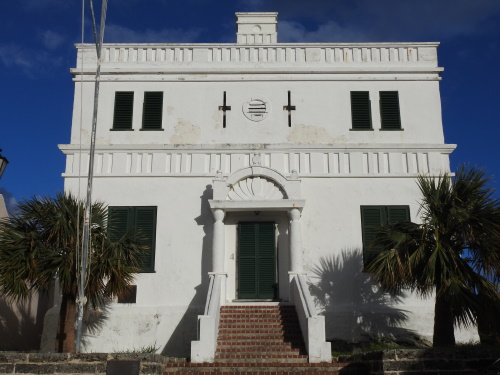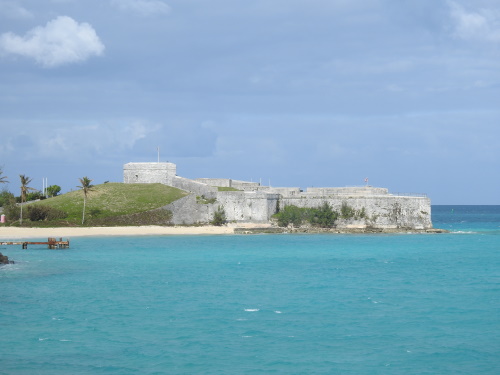Blog WHS Visits
WHS #726: St. George, Bermuda
I recently amended my WHS coverage strategy from purely looking for the hotspots to also going out of my way twice a year for a difficult / expensive WHS (expecting that when I get older I will have more time to travel, but physical challenges will get harder and the money less easily replenished). An odd one among the latter set of WHS is St. George, Bermuda – one of our most isolated WHS (it’s 1,200km from Independence Hall). The island group of Bermuda is not a particularly hard destination to reach, but it is mostly visited from the US or via a cruise. From Europe there’s only one British Airways flight a day. And it surely ticks the “expensive” box: start from UK price level, add a logistical surcharge as most things have to be flown in, take the cruise ship price inflation into account and finally the American-style 15-20% tipping. In the end this ‘tick’ costed me some 1,500 EUR.
The WHS is located on and around one of the northernmost islands of the Bermuda archipelago: St. George Island. The town is known as “St. George’s” (short for St. George’s Town), but it seems to have lost its “’s” in the official WHS name: The Historic Town of St. George and Related Fortifications, Bermuda. Note also the addition of “Bermuda” at the end – there are so many towns called St. George around the world that the Bermudians probably wanted it to be clear that their St. George was honored.
I stayed for 3 nights in a B&B in St. George, in the core zone. So I walked straight into the historic center of St. George from my front door. In 'my' street I found already a beautiful house with all the characteristics of the unique architecture of Bermuda: colorfully painted, with a stepped roof so rainwater can be collected, a chimney and curved stairs (“welcoming arms”) giving access to the property.
The historic center is fairly authentic: 65% of the houses date from before 1900, and another 40% of them from before 1800. Most buildings have been given a contemporary purpose: they’ve been turned into shops, restaurants, hotels - though without giving it a too commercial feel. The oldest stone building on the island is the State House from 1621 (see photo below). Here the parliament of Bermuda met until 1825. It is now owned by a local Masonic lodge. It was constructed in a very different style from the rest of the town center, it reminded me a bit of Angra do Heroismo in the Azores.
When I was done with the town, I started on a walk around St. George’s Island. Forts have been built here over the centuries at various strategic places at the coast and on islands off the coast. 23 of them are included in the WHS as separate locations. I just walked on the main road: there is so little traffic that it is easy to do.
The first fort that I came across is Gates Fort. A fort stood on this tip of land as early as 1626. Later a 2 storey guard house was added. It’s just a tiny outpost that wouldn't have withstood any serious attack. The Alexandra Battery lies not much further along the coast. This defense work is a lot newer: most of what is on display now comes from 1904. The terrain is partly overgrown and the cannons are rusty. Just as with Gates Fort, a tourist doing the forts loop on a scooter and myself were the only ones visiting.
The largest fort lies on the north side of the island: Fort St. Catherine. You can see it from afar. Getting there on foot requires a long detour: part of the coastal route has been closed off because they are building a large hotel annex apartment complex. A caretaker of the fort that I spoke to later was seriously angry about it: what a disdain for this historic stretch of coast, including the beach where the first Englishmen came ashore!
Fort St. Catherine has been converted into a museum. After paying 7 USD, I followed the route through the complex. It goes mostly underground, giving you a good idea of how the logistics of an active fortress worked. Bullets and gunpowder were stored in cellars and were hoisted when needed to the firing guns.
The exhibition also tells about the lives of the British soldiers who were sent here. Certainly the earlier ones were not really given a lot of priority within the Empire: there was even a group that was left to fend for themselves for 13 years or so, until another ship came along with their replacements. The fortifications around St. George guarded access to the British naval port and shipyard on the main island, now the Royal Naval Dockyard. Upon inscription it was advised by ICOMOS to add the Dockyard to the nominated area as an extension, but that never materialized.
Els - 24 November 2019


